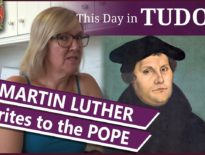On this day in Tudor history, 7th September 1533, just over two months after the death of his previous wife, Mary Tudor. Queen of France, forty-nine-year-old Charles Brandon, Duke of Suffolk, married his ward, fourteen-year-old Catherine Willoughby.
Find out more about this Tudor couple, how they came to be married, what their marriage was like, and what happened to them, in today's talk.
Also on this day in Tudor history, 7th September 1533, the very same day, Queen Elizabeth I, daughter of King Henry VIII and his second wife, Anne Boleyn, was born at Greenwich Palace. Find out more about her birth, the reactions and celebrations in last year’s video:
Also on this day in history:
- 1500 – Birth of Sebastian Newdigate, member of Henry VIII's Privy Chamber, Carthusian monk and Roman Catholic martyr, at Harefield in Middlesex.
- 1523 – Birth of Alice Barnham (née Bradbridge), silkwoman and benefactor, at Chichester. Alice is known for being one of the subjects of one of the earliest English family group portraits: “Alice Barnham and her Sons Martin and Steven” (once entitled “Lady Ingram and her Two Boys Martin and Steven” in error) from 1557.
- 1571 – Arrest of Thomas Howard, 4th Duke of Norfolk, for his part in the Ridolfi Plot to assassinate Elizabeth I and to replace her with Mary, Queen of Scots. Howard confessed to corresponding with Mary's supporters and was taken to the Tower of London. He was executed on 2nd June 1572 after being found guilty of high treason.
- 1587 – Burial of Richard Barnes, Bishop of Durham during Elizabeth I's reign, in the choir of Durham Cathedral.
Transcript:
On this day in Tudor history, 7th September 1533, just over two months after the death of his previous wife, Mary Tudor. Queen of France, forty-nine-year-old Charles Brandon, Duke of Suffolk, married his ward, fourteen-year-old Catherine Willoughby.
Now, a 49 year-old man marrying a teenager might sound rather icky to us today, but it wasn’t abnormal in Tudor times, and it was actually good for the bride in that her husband was well-advanced in his career and could provide well for her. It was also highly probably that he wouldn’t be long for this world and as a widow she’d have more freedom in who she could choose for her next husband, and she’d be in a good position financially when she could make that choice. It was a win-win situation as the groom got a young wife who was more likely to be fertile than a woman his own age, to give him an heir and a spare if he didn’t already have one.
Let me share a few facts about this Tudor couple…
• Catherine was the daughter and only child of William Willoughby, 11th Baron Willoughby de Eresby, and Lady Maria de Salinas, lady-in-waiting to Catherine of Aragon, and a woman who’d travelled to be with Catherine of Aragon during her final hours. She was born on 22nd March 1519.
• Catherine’s father died in 1526 and in February 1529 her wardship was purchased by Charles Brandon, Duke of Suffolk, who was married to Henry VIII’s sister, Mary Tudor , Queen of France.
• It appears that Catherine was initially seen as a potential bride for Suffolk’s son, Henry Brandon, 1st Earl of Lincoln, who was ten in 1533, but it may have been clear that he was ill and not likely to survive and Suffolk was desperate to keep control of the Willoughby estates. Lincoln did indeed die young, dying in 1534.
• After Mary Tudor’s death on 25th June 1533, Catherine played chief mourner at her funeral.
• Stephen Gunn points out that “Mary's death necessitated a financial reckoning with the crown, one which cost the duke all his Oxfordshire and Berkshire estates and Suffolk Place in Southwark” so Suffolk needed Catherine’s estates.
• The couple married on this day in 1533 and Suffolk fought Catherine’s uncle, Sir Christopher Willoughby, for her father’s lands, a fight which was concluded in Suffolk’s favour by 1536.
• Even though there was over 30 years between them, the Willoughby-Brandon marriage was successful, and Catherine gave Suffolk two sons, Henry and Charles.
• Catherine attended the funeral of Catherine of Aragon in 1536 and in the autumn of 1536, Suffolk was one of those involved in putting down the Pilgrimage of Grace rebellion in the North of England.
• Suffolk spent much of his final years at home in Lincolnshire, but he did serve on the Privy Council and was active in Henry VIII’s campaigns against Scotland and France in the early 1540s. In 1541, he played host at Grimsthorpe to the king and his fifth wife Catherine Howard on their northern progress.
• In 1544, just a year before his death, he was commanding troops in France.
• Suffolk died on 22nd August 1545 at Guildford at around 61 years of age. It is not known what caused his death and he was just about to lead troops in Boulogne. He was buried in St George’s Chapel, Windsor.
• Suffolk appears to have been a conservative in terms of religion, requesting dirges in his will, but his young wife was a zealous reformer and acted as patron to up and coming reformers, employing Bible translator Miles Coverdale as tutor to her sons.
• Catherine was made ward of their eldest son, Henry, who became 2nd Duke of Suffolk on his father’s death and who was sent to court to be educated with Prince Edward, the future Edward VI.
• Sadly, Charles and Catherine’s sons, Henry and Charles, died on 14th July 1551. An epidemic of sweating sickness had struck and the boys left their studies at Cambridge and travelled to Buckden. Henry died first, leaving the dukedom to Charles who survived him by only 30 minutes or so.
• Catherine and her friend, Queen Catherine Parr, were lucky to escape being caught up in the execution of Protestant Anne Askew in 1546, and Catherine was not backwards regarding her feelings about Catholic conservative Stephen Gardiner, Bishop of Winchester, allegedly calling her dog Gardiner so that she could call him to heel in the bishop’s presence.
• In 1552, Catherine married her gentleman usher, Richard Bertie, and had two children by him: Susan and Peregrine.
• Catherine died on 19th September 1580 at the age of 61. She was buried in Spilsby Church, Lincolnshire.



Was Catherine Willoughby ever sought after by Sir Robert Dudley 1527? As a contemporary of Elizabeth Tudor he could not publically marry the Queen, but he did get close with Lettice Knolleys, daughter of Mary Boleyn, who may have been the Kings Blood ? If the King was interested in the Catherine the daughter of his first wife’s Lady in Waiting, perhaps Dudley would have targeted her as well?